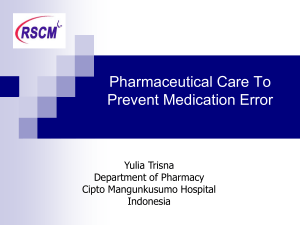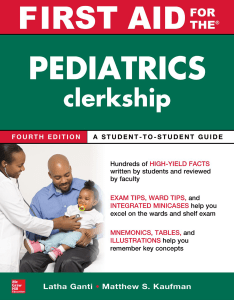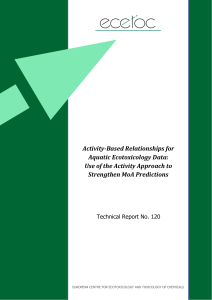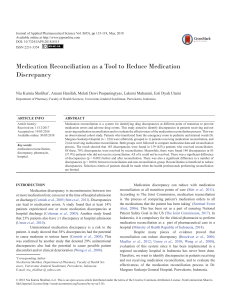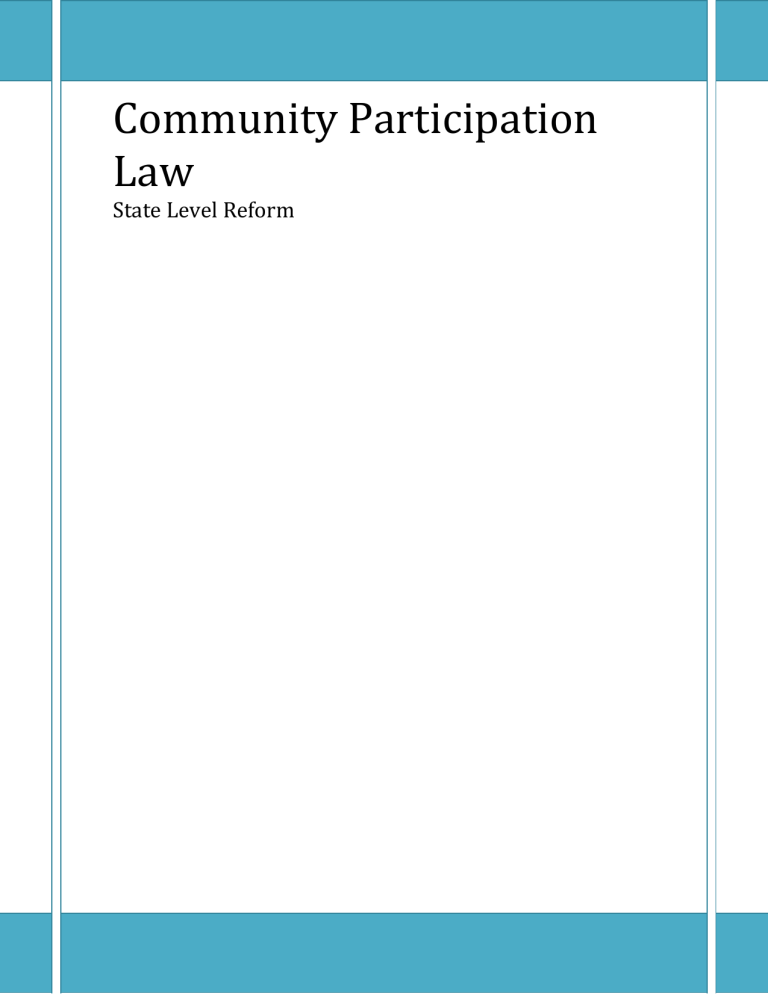
Community Participation Law State Level Reform Community Participation Law 1. The Reform The Community Participation Law (CPL) is aimed at: Strengthening municipal governments by: o Institutionalizing citizen participation. o Introducing the concept of Area Sabhas (consisting of all registered voters of a polling booth) in urban areas. Involving citizens in municipal functions like setting priorities, budgeting provisions, exerting pressure for compliance of existing regulations, etc. JNNURM contemplates the creation of another tier of decision-making in the municipality which is below the ward level, called the Area Sabha. All the Area Sabhas in a ward will be linked to the ward level ward committee through Area Sabha representatives, who will be community representatives. There will thus be a minimum of 3 tiers of decision-making in a municipality, namely, the municipality, the ward committee, and the Area Sabhas. In addition, states may choose to have an intermediary level for administrative reasons, clustering multiple wards into a regional structure between the ward and the municipality. The CPL is a mandatory reform under the JNNURM and it refers to making appropriate provisions in the state-level municipal statute(s) for the establishment of such a three/four-tiered structure. The JNNURM makes it mandatory for states to either enact a separate CPL or make appropriate amendments to their existing municipal laws. These enactments will need to ensure clear definition of functions, duties and powers of each of these tiers, and provide for appropriate devolution of funds, functions and MUNICIPALITY functionaries to these levels. The figure on the right illustrates the proposed structure. WARD CORPORATOR/ COUNCILLOR URBAN AREA FOOTPRINT WARDS COMMITTEE AREA SABHA REPRESENTATIVE WARD COMMITTEE WARD FOOTPRINT AREA EVERY REGISTERED VOTER IN THE POLLING STATION JNNURM Primers POLLING STATION FOOTPRINT Page 2 Community Participation Law 2. Rationale for the reform Citizen participation is essential for making democratic processes effective and for strengthening them. It provides a platform to citizens to influence policy/program development and implementation. While various platforms and systems for citizen’s participation have developed organically there is a need to institutionalize them to make them effective and sustainable. The CPL aims to institutionalize such community participation platforms/systems. If implemented in its true spirit it will have the following advantages: 3. It will help deepen democracy, facilitate efficiency and sustained socio-economic growth and promote pro-poor initiatives. It will help in improving urban governance and service delivery. It will promote transparency and accountability in governance. It will improve the quality of the decisions made, as these would be based on knowledge of local realities and requirements. It has significance for regional planning structures like the District Planning Committee (DPC) and the Metropolitan Planning Committee (MPC) both of which require citizen participation in planning from the grassroots. Citizens will have a say in determining how information is shared, policies are set, resources are used and plans/programs are implemented. Reform components and timelines Components Timelines Resolution by the state government expressing To be passed within 6 months of signing of commitment to establish a new CPL MoA under the Mission and submitting a copy to the Ministry of Urban Development Interim process for community participation in Within a year of signing the MoA municipal functions while CPL is being enacted and notified (see below) Progressive devolution of functions to the Within a year of signing the MoA lower tiers. For e.g., the municipality may devolve monitoring of solid waste management to the lower tiers of Area Sabha to provide political education to the grassroots Enactment of the law by the states according to As per the timeline committed to by each state the timeline committed to by them in the tripartite Memorandum of Agreement (MoA) signed by them Notification of the ‘Rules’ pertaining to the As per the timeline committed to by each state CPL or amendment in legislation Interim Processes The interim process could be any of the following: A transitional semi-permanent structure set up across the city that can later blend seamlessly into Area Sabha structure when statutes are operationalized. JNNURM Primers Page 3 Community Participation Law o Mysore example: A citizen committee created for every polling booth that is represented at the respective zonal committee. The zonal committee members are selected from among the members of the citizen committees present in the zone. Temporary citywide structure with a specific intention e.g., development of revised CDP for master planning, etc. Undertaking pilot programs in selected pockets of the city for select urban services. For example, participative platforms can be created at the polling booth levels for monitoring the segregation of solid waste. Steps involved in drafting the CPL: The state should decide on whether to provide a four-tier (with an intermediary/regional committee) or a three-tier (without the intermediary committee) structure for participation. The state should decide whether the provision would be restricted to certain types of ULBs. That is, the structure could depend on the size of the ULB. For example, the legislative provision for a three/four-tier structure could apply to ULBs with population of more than a lakh. The structure could be two-tiered (at city and ward levels) when the ward population is a manageable size. The legislation should provide the link between the different tiers, especially between an Area Sabha and a ward committee. This could be through the Area Sabha representatives, who may be either elected by the voters in the area or nominated by the ward councilor. The legislation should also specify the manner of selection of the Area Sabha representative and provide the voters the right to recall, if they are dissatisfied with their representative. The state should decide on the functions that it would devolve to the different tiers below the municipal level. The legislation should provide an activity mapping of functions under each tier. The legislation should provide for the responsibilities (based on the activity mapping) and powers of the different tiers. Finally, the legislation should also specify the role of the convener of the different tiers of participation, especially Area Sabha representative, chairperson of ward committee and zonal committee (if present). The rules specified under the law should spell out the guidelines for conducting the business of the different tiers specifying the process for arriving at the business agenda and resolutions and also provide for checks and balances for the optimal functioning of the different platforms. JNNURM Primers Page 4 Community Participation Law 4. Measuring Achievement/Outcomes Resolution by the state governments on establishment of a three/four-tier municipal structure (the municipality, the ward committee and the Area Sabha) in the state along the footprint of the electoral polling station. o Measure: Adherence to the timeline: six months from the signing of MoA. Introduction of interim participatory platforms mentioned above that will make way for the formal structures upon passing the law. o Measure: Number of municipalities in a state with such platforms. Devolution of functions. o Measure: Number of functions devolved and role of the different tiers with respect to each of them. A report documenting the efforts, successes, failures. o Measure: Comprehensibility of the document. Enactment of law. o Measure: Extent of conformity with the spirit of the Model Law. Empowerment of the different tiers. o Measure: Provision of funds and capacity building at the required tier(s). JNNURM Primers Page 5
